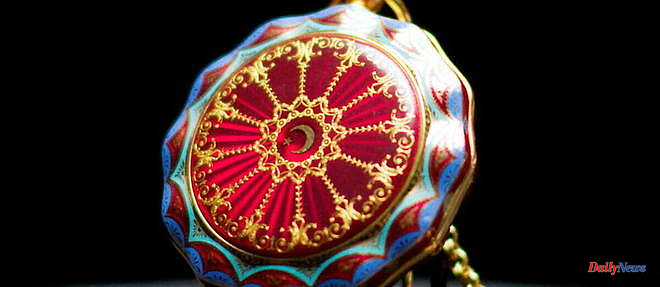"To wear a beautiful Breguet watch is to feel that you have the brain of a genius in your pocket", David Salomons, the world's greatest collector of Breguet watches, used to say. Indeed, the genius of its founder and his avant-garde inventiveness make Breguet the watchmaker who knew how to transform the discipline into a science. The manufacture's timepieces often tell the great and the small story since Abraham-Louis Breguet – the father of modern watchmaking – filled his notebook with numerous royal orders following his appointment as master watchmaker in 1784. From Louis XVI to Marie-Antoinette, passing by Napoleon Bonaparte, King George III of England or Tsar Alexander I of Russia, all wore a Breguet on their wrist.
"This devil of Breguet, who always wanted to do other than better", according to Talleyrand, will be honored next May 14 at Sotheby's. In Geneva, the house will orchestrate its sale called "Centuries of Time: A Private Collection" as part of the Luxury Week auction. This is the dispersal of one of the world's largest private collections of pocket watches. A selection of nearly one hundred pieces with an overall estimate of between 1.8 and 3.4 million Swiss francs. Purchased for forty-five years by a shrewd collector, these watches will allow bidders to explore the history of watchmaking from the 16th to the beginning of the 20th century, with rare pieces, complex mechanisms and fascinating enamels. Above all, and beyond an epic through time, the sale will reflect the importance of the orders made to watchmakers by the Eastern and Far Eastern markets. This is particularly the case for the flagship lot of this auction, led by an extremely rare watch signed Breguet and made at the dawn of the 19th century for the Sultan of the Ottoman Empire. It is expected between 500,000 and 1 million Swiss francs.
In the early years of the 19th century, Breguet's main foreign markets were England, Spain and Russia. The Emperor of Russia, Alexander I, became an assiduous customer and gave the house the official title of Clockmaker to His Majesty and to the Imperial Navy. Faced with the enthusiasm of Russian customers, Breguet created an establishment in 1808 in Saint Petersburg: the Maison de Russie. However, following the political difficulties of the end of the Empire and at a time when the Napoleonic wars were raging in Europe, the brand's exports were heavily hampered.
To compensate for the lost markets, Breguet then decided to develop its sales elsewhere. His interest is in the Ottoman Empire since Breguet knew the sultans' passion for rare watches with rich enamelling. A passion aroused as early as the 16th century when Western emissaries began to present Haute Horlogerie references to Constantinople to curry favor with the elite. This, without forgetting the religion which also played an important role in stimulating the attraction of the local upper classes for watches. Indeed, according to the principles of Islam, the Ottomans had to pray five times a day at specific times, hence the usefulness of having a pocket watch at hand, especially since the latter wore outside their clothes, which meant that their decorative elements took on great importance.
This induction of Breguet for the Ottoman market officially began in 1797 when their ambassador to France, Ali Effendi (known as Galib Effendi) then Minister of the Navy, was introduced into Parisian high society by Charles-Maurice de Talleyrand-Périgord. Subsequently, in 1804, Galib ordered from Breguet the first pocket watch for the benefit of the ruler of the Ottoman Empire in place at the time, Selim III. This sale was a success since in Constantinople, Breguet's reputation was at its height. The house thus received many other orders from the sultan and his successors, such as the piece soon to be sold at Sotheby's.
Archived under number 1950 in the annals of Breguet, the watch offered at auction is a horological masterpiece. It is a 22-carat gold reference mounted on a double case called "Cabriolet". In other words, a technique which allows the watch to be used either open, in order to observe the white enamel dial and the Breguet blued hands, or closed, to enjoy the red and blue polychrome decoration of the exterior design, specially produced for the Ottoman market.
Entirely enamelled, the timepiece embeds multiple Breguet complications such as a small and large strike, as well as a minute repeater thanks to five hammers striking five gongs. A clever mechanism built from a caliber drawing dating from 1796 with only six examples.
Ordered from Breguet in 1805 by Galib Effendi for his suzerain, the watch was completed on December 31, 1807 before being sold on May 6, 1808 to the Ottoman ambassador under the order number 1950. This, for the sum of 4,000 francs , one of Breguet's most expensive watches at the time. Overthrown by a revolt fomented by the Janissaries, Sélim III was executed on July 28, 1808. Unable to be the owner of pocket watch N°1950 with certainty, it is therefore very likely that it was offered to his successor. , Sultan Mahmud II who reigned over the Ottoman Empire until 1839. In any case, the watch, as a piece of history in its own right, will certainly trigger a great bidding battle between enthusiasts and why not, the Breguet house itself. Case to follow.
"Centuries of Time: A Private Collection", May 14, 2023, Sotheby's Geneva, 2, Rue François-Diday Geneva 1204, Switzerland.












